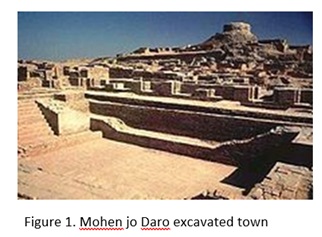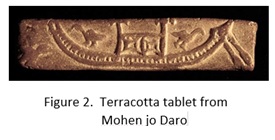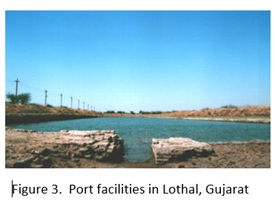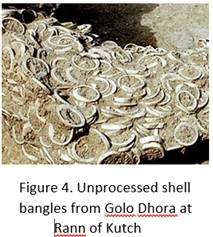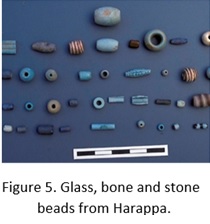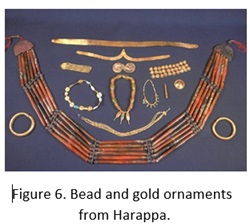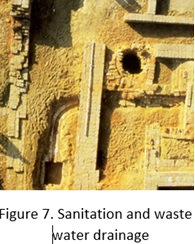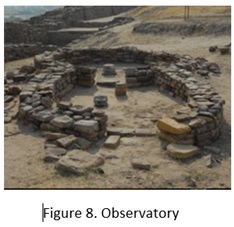India Prehistory and Indus Period - Science and Technology
Agriculture and irrigation represent some of the early traces of technological innovation in India. Stone tools found in Bhimbetka suggest that the Neolithic cave dwellers were adept in mechanical skills and had likely developed knowledge of high-heat smelting. Pendant-like copper sheets suggest the use of metals, and pottery shards indicate the use of pots in cooking and food storage. Early traces of grain have been discovered at Mehrgarh in modern Pakistan, and are dated to about from 7000 BCE. Rice farming can be traced to the Eastern highlands of the Indian subcontinent from the pre-historic period.
The urban settlements found in the valleys of twin rivers Indus and Saraswati are together believed to have evolved around 5000 BCE and continued until 2000 BCE. Excavations indicate the use of town-planning, roads, housing, granaries, baths and underground sewerage systems (Figure 1). The manufacture of standard-sized bricks and their use in construction count as significant achievements in world history, while use of measurements and sizing point to knowledge of counting and number systems. A system of wide roads possibly enabled wheeled transports to ply, but we don’t have any records of such vehicles.
Settlers in this area were agriculturists and traders. They collected rainwater through an extensive reservoir system, which also was a major innovation. The use of granaries and production centers is indicated as also of sturdy sacks, which likely helped the export of grain to far-away lands. We can infer that the people had a rudimentary knowledge of weaving to create sacks and some textiles. The extent of cultural development is documented by the Indus seals: an engraved terracotta token was apparently used to tag the sacks, and the seal showing a priest-like person (see Track IV, Philosophy and Religion) suggests the use of textile garments. Cotton cultivation had likely already started.
Evidence also suggests that Indus traders engineered boat making (Figure 2) and were able to construct port facilities (Figure 3). Port ruins have been discovered in Lothal in the modern state of Gujarat, India – the port may have allowed inland river traffic as well as marine traffic through the coastal sea. Copper and gold were likely among the items that were imported, and beads and ornaments were among the exported goods. Engineering tools for fabrication have also been discovered and production centers in various towns have been unearthed.
Manufacture of glass and bone beads was a part of the industrial preoccupation of the time, and clearly the technology for producing glass from silica was known. Bone beads were made from animal bones cut to size. Dried and seasoned egg-shells were also used. Stringing beads by fiber ropes seems to have been a household practice. Steatite (soapstone) was used to make larger beads. Metal inlay had been developed as an art, and gold dust-coated beads as well as gold jewelry have been discovered in Harappa (Figure 6).
The discovery of a copper statue of a bull, and that of an ornamented woman (Please see Track II, Art and Culture) indicate a fair amount of use of copper and lost wax technology. Holed terracotta bird-shaped hollow toy-like objects appear to be bird-whistles. Holes in barrels of bones could indicate flute-like musical instruments.
Health and sanitation were among the important public heath concerns involved in town planning. Pit latrines, sewerage drains and underground sewer disposal were integral parts of construction (Figure7). Bath houses. and liberal use as well as disposal of water, were carefully planned, although the civilization later suffered due to water scarcity caused by climate change and shifting river beds. There are hints of an observatory for astronomical and weather observations (Figure 8).
The entire region was deserted by about 1700BC.
-----------------------------------------------------------------------------------
Dr. Bijoy Misra leads the Science and Technology track in India Discovery Center's project on "Evolution of Indian Culture: Pre-history to 1947AD".
More information and updates on the project are available at
(c) Copyright 2021 India Discovery Center, Inc. All rights reserved.
.jpg)
